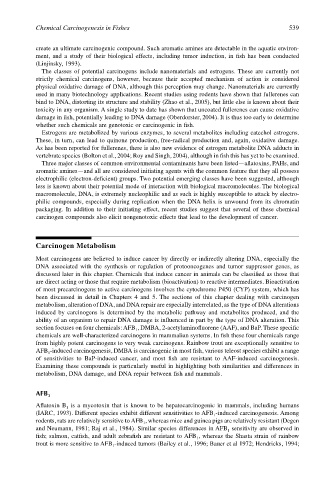Page 559 - The Toxicology of Fishes
P. 559
Chemical Carcinogenesis in Fishes 539
create an ultimate carcinogenic compound. Such aromatic amines are detectable in the aquatic environ-
ment, and a study of their biological effects, including tumor induction, in fish has been conducted
(Linjinsky, 1993).
The classes of potential carcinogens include nanomaterials and estrogens. These are currently not
strictly chemical carcinogens, however, because their accepted mechanism of action is considered
physical oxidative damage of DNA, although this perception may change. Nanomaterials are currently
used in many biotechnology applications. Recent studies using rodents have shown that fullerenes can
bind to DNA, distorting its structure and stability (Zhao et al., 2005), but little else is known about their
toxicity in any organism. A single study to date has shown that uncoated fullerenes can cause oxidative
damage in fish, potentially leading to DNA damage (Oberdorster, 2004). It is thus too early to determine
whether such chemicals are genotoxic or carcinogenic in fish.
Estrogens are metabolized by various enzymes, to several metabolites including catechol estrogens.
These, in turn, can lead to quinone production, free-radical production and, again, oxidative damage.
As has been reported for fullerenes, there is also new evidence of estrogen metabolite DNA adducts in
vertebrate species (Bolton et al., 2004; Roy and Singh, 2004), although in fish this has yet to be examined.
Three major classes of common environmental contaminants have been listed—aflatoxins, PAHs, and
aromatic amines—and all are considered initiating agents with the common feature that they all possess
electrophilic (electron-deficient) groups. Two potential emerging classes have been suggested, although
less is known about their potential mode of interaction with biological macromolecules. The biological
macromolecule, DNA, is extremely nucleophilic and as such is highly susceptible to attack by electro-
philic compounds, especially during replication when the DNA helix is unwound from its chromatin
packaging. In addition to their initiating effect, recent studies suggest that several of these chemical
carcinogen compounds also elicit nongenotoxic effects that lead to the development of cancer.
Carcinogen Metabolism
Most carcinogens are believed to induce cancer by directly or indirectly altering DNA, especially the
DNA associated with the synthesis or regulation of protooncogenes and tumor suppressor genes, as
discussed later in this chapter. Chemicals that induce cancer in animals can be classified as those that
are direct acting or those that require metabolism (bioactivation) to reactive intermediates. Bioactivation
of most precarcinogens to active carcinogens involves the cytochrome P450 (CYP) system, which has
been discussed in detail in Chapters 4 and 5. The sections of this chapter dealing with carcinogen
metabolism, alteration of DNA, and DNA repair are especially interrelated, as the type of DNA alterations
induced by carcinogens is determined by the metabolic pathway and metabolites produced, and the
ability of an organism to repair DNA damage is influenced in part by the type of DNA alteration. This
section focuses on four chemicals: AFB , DMBA, 2-acetylaminofluorene (AAF), and BaP. These specific
1
chemicals are well-characterized carcinogens in mammalian systems. In fish these four chemicals range
from highly potent carcinogens to very weak carcinogens. Rainbow trout are exceptionally sensitive to
AFB -induced carcinogenesis, DMBA is carcinogenic in most fish, various teleost species exhibit a range
1
of sensitivities to BaP-induced cancer, and most fish are resistant to AAF-induced carcinogenesis.
Examining these compounds is particularly useful in highlighting both similarities and differences in
metabolism, DNA damage, and DNA repair between fish and mammals.
AFB 1
Aflatoxin B is a mycotoxin that is known to be hepatocarcinogenic in mammals, including humans
1
(IARC, 1993). Different species exhibit different sensitivities to AFB -induced carcinogenesis. Among
1
rodents, rats are relatively sensitive to AFB , whereas mice and guinea pigs are relatively resistant (Degen
1
and Neumann, 1981; Raj et al., 1984). Similar species differences in AFB sensitivity are observed in
1
fish; salmon, catfish, and adult zebrafish are resistant to AFB , whereas the Shasta strain of rainbow
1
trout is more sensitive to AFB -induced tumors (Bailey et al., 1996; Bauer et al 1972; Hendricks, 1994;
1

